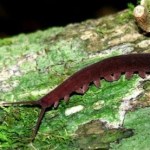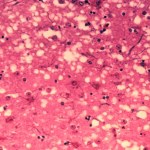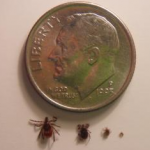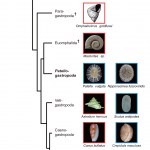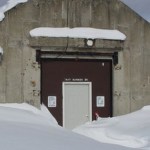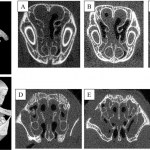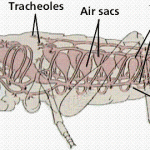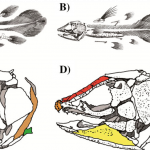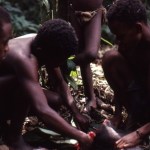Life Sciences
Image of velvet worm from: Oliveira et al / Zoologischer Anzeiger
A new species of velvet worm (Eoperipatus totoros) is the first to be described from Vietnam after its discovery in 2010. This 2.5 inch long worm is distinguished from other velvet worms by hairs with unique shapes that cover its body. These animals are difficult to find and study because they are usually hiding in the moist soil to prevent dehydration. However, during the rainy season, they exit the soil and can be spotted. What is neat about these worms is that they hunt by spraying a glue-like…
Life has been growing on Earth for about 4 billion years, and during that time there have been a handful of mass extinctions that have wiped out a large percentage of complex lifeforms. Asteroid impact, volcanic eruption, climate change, anoxia, and poison have dispatched untold numbers of once-successful species to total oblivion or a few lucky fossils. Species also die off regularly for much less spectacular reasons, and altogether about 98% of documented species no longer exist.
Cry me a river, you say, without all that death there would have been no gap for vertebrates, for…
The Bottleneck Years
by H.E. Taylor
Chapter 49
Table of Contents
Chapter 51
Chapter 50
Eco 110 - Carrying Capacity, January 15, 2057
Notes on a lecture
It was the first class of the term. I was purposefully late, because I wanted everyone to be present and impatient. I walked in, dropped my case on the wide black presentation desk and turned to face the old theatre style hall.
"Okay, here is the question: Are we collectively smarter than a vat of yeast?"
I let that sink in for a few seconds, then continued with:
"The topic for today is carrying capacity.
"Intuitively, the idea is how…
Image of the 52 Hertz whale song from Wikimedia Commons, NOAA.
According to Discovery News, scientists and filmmakers are on the hunt for what people have called the Loneliest Whale in the World.
In 1989 William Watkins (Woods Hole Oceanographic Institution) discovered the vocalizations of a whale that were unlike that of any other whale. The vocalizations of the mystery whale were 52 Hertz whereas other whales sing in the 17-18 Hertz range, allowing their songs to travel far distances. Beginning in 1992, he and his team started tracking the movements of the 52 Hertz whale using…
The evidence from real-world observations, sophisticated computer models, and research in hundreds of different fields continues to pile up: human-caused climate change is already occurring and will continue to get worse and worse as greenhouse-gas concentrations continue to rise.
Because the climate is connected to every major geophysical, chemical, and biological system on the planet, it should not be surprising that we are learning more and more about the potential implications of these changes for a remarkably wide range of things. And while it is certainly possible – even likely – that…
I know you're thinking we've had more than enough discussion of one simplistic umbrella hypothesis for the origin of unique human traits — the aquatic ape hypothesis — and it's cruel of me to introduce another, but who knows, maybe the proponents of each will collide and mutually annihilate each other, and then we'll all be happy. Besides, this new idea is hilarious. I'm calling it the MFAP hypothesis of human origins, which the original author probably wouldn't care for (for reasons that will become clear in a moment), but I think it's very accurate.
A list of traits distinguishing humans…
Student guest post by McKenzie Steger
Off the southeastern coast of Australia lies a small island that in the 1700 and 1800’s was inhabited by the very worst of Europe’s criminals and is now the only natural home in the world to a species named after the devil himself. Decades later beginning in 1996 Tasmanian devils were going about their nocturnal lifestyle in normal devilish fashion feasting on small mammals and birds, finding mates and reproducing, occasionally fighting with one another and so on. (1) Just as criminals divvied up their booty hundreds of years before, the devils were…
Student guest post by Bradley Christensen
No, this isn’t a clip from a science fiction movie. Although dramatic, this does occur in the brains of some people and animals around on our home planet. What is a prion you ask? Prions are almost as mysterious to the scientists that research them as they are to me, you and the neighbor down the street. Prion is a term used to describe an abnormal and particularly destructive strand of protein found in the brain. Proteins are the building blocks of the muscles and tissues of our bodies that work combine together to…
Student guest post by Kyle Malter
In many areas of the country there is a vile blood sucker that lurks in our forests, our parks and even our backyards. What concerns us is not what this creature takes but rather what it leaves in our body after it bites us: corkscrew shaped bacteria called spirochetes and with the name Borrelia burgdorferi. When the bacteria invade our bodies and cause problems along the way we call it Lyme disease.
It is Lyme, not “Lymes” disease, and here’s how it got that name. In the early 1970’s a large number of cases emerged involving children with a…
Daniel Friedmann has found it! It's the scaling factor that lets you convert the 'days' of God in the book of Genesis into human years. This is reported with total credulity in the Toronto Star.
Let’s take the word “day.” In terms of the first six days, they’re “creation days,” which are different from just days. There are a number of sources in all the religions that interpret those days as periods of time.
I’m certainly not the first. What is unique about my work is that I went into the sources and I said, “Look, if the Bible is self-contained and if I say a day is not 24 hours, then what…
Typically, snails coil as they grow. The exact shape and characteristics of the coil are known to be a combination of genetic and environmental factors, depending on the snail. There is an interesting story involving snails and the young Jean Piaget. Piaget is famous for his work in psychology, but before that, when he was quite young, he worked with birds and mollusks. His work was published and otherwise disseminated and experts in these areas, unaware that he was a teenager, assumed he was an adult expert on natural history. Anyway, Piaget studied, among other things, a group of snail…
Those of us who support science-based medicine and do our part to expose and combat quackery are naturally outraged at how rarely quacks are prosecuted to the fullest extent of the law. All too often, all we can expect is for doctors practicing such chicanery to lose their medical licenses and be temporarily shut down. I say "temporarily" because it's all too often that such physicians manage to obtain licenses in other states. Hopping from location to location, such doctors can often practice for years relatively unmolested by the law, because most states have relatively ineffective state…
A Cold War bunker at Loring Air Force Base in Maine that has been converted into a winter haven for bats. Image from: BBC News, USFWS/S. Agius
Scientists in Maine have converted two Cold War bunkers at Loring Air Force Base into winter havens for bats in an effort to protect the animals from the fungus that causes white nose syndrome. What is nice about using a man-made space is that they can actually clean up the area as opposed to trying to kill the fungus in a cave where multiple species of fungi may be affected, thereby disrupting the micro-ecosystem. The winter survival…
I think BAHFest — the festival of Bad Ad Hoc Hypotheses — has been made entirely redundant. It's an event to mock the absurdly adaptationist hypotheses put forward by some scientists, and it's intended to be extravagantly ridiculous. But then, you look at some ideas that are inexplicably popular among scientists, and you realize…it's a little too close to reality.
I'm speaking of the Aquatic Ape Hypothesis.
The Guardian is running yet another article on the goofy idea that we evolved from swimming apes, and that all of the unique features of our species are a product of adaptations to an…
Today's symposia included a session on "Integrative Cardiovascular and Respiratory Physiology of Non-model Organisms" as well as the August Krogh Distinguished Lecture.
This year's Krogh lecture was given by Dr. Stan Lindstedt from Northern Arizona University. Dr. Lindstedt is arguably best known for publishing work showing that the metabolic rate of an animal is negatively correlated with body mass. In other words, smaller animals have a higher metabolic rate than larger animals. Knowing that relationship could have saved Tusko the elephant from a whopping dose of LSD (1962, prior to the…
Another exciting day for Comparative Physiology! I just got back to my hotel after the wonderful dinner meeting overlooking the Harbor.
Of course, the research was exciting too :)
Here are the highlights from today's sessions:
Heinrich E, Bradley T. Univ California, Irvine I learned a lot about the insect tracheal system this morning. Insects do not have continuous gas exchange with environment like we do. Rather, gas exchange is discontinuous and involves valves, called spiracles:
Diagram of how insects breathe from www.breatheornot.wordpress.com
When carbon dioxide levels increase…
The coelacanth genome has been sequenced, which is good news all around…except that I found a few of the comments in the article announcing it disconcerting. They keep calling it a "living fossil" — and you know what I think of that term — and they keep referring to it as evolving slowly
The slowly evolving coelacanth
The morphological resemblance of the modern coelacanth to its fossil ancestors has resulted in it being nicknamed ‘the living fossil’. This invites the question of whether the genome of the coelacanth is as slowly evolving as its outward appearance suggests. Earlier work showed…
All human hunter-gatherer groups that have been studied incorporate meat in their diets. Studies have shown that the total dietary contribution of meat varies a great deal, and seems to increase with latitude so that foragers in subarctic and arctic regions eat a lot of meat while those living near the equator eat less. It is probably true that tropical and subtropical foragers obtain more of their calories from plants than from meat over any reasonable amount of time. The meat consists primarily of mammals for most groups, but fish, birds, reptiles, and invertebrates can reach high…
Earlier today, Maggie Koerth-Baker posted this tweet:
I dig this graph, but I think it misses an outreach opportunity by ascribing common misconceptions to creationists only bouncingdodecahedrons.tumblr.com/post/17808416988
It links to a diagram showing evolution as a linear path rather than a branching tree, and it got me thinking about terribly popular misconceptions about evolution that were started by smart people, and a doozy came to mind. A whole collection of doozies, actually, from one single terribly clever person.
You've all heard the stupid creationist objection to evolution — "if…
“If the Universe Is Teeming with Aliens… Where Is Everybody?” -Stephen Webb
It's one of the biggest conundrums in the Universe, known as the Fermi Paradox: if the Universe is so conducive to life, and if there are so many opportunities for it within our galaxy alone, why isn't there any evidence (outside of the History Channel) of extraterrestrial life?
Image credit: Peter Essick, via National Geographic.
Moreover, why haven't we been visited by some extraterrestrial intelligence? After all, given the fact that our Universe is nearly 14 billion years old, while our galaxy itself is…
